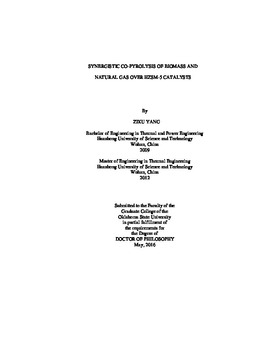| dc.contributor.advisor | Kumar, Ajay | |
| dc.contributor.author | Yang, Zixu | |
| dc.date.accessioned | 2019-08-19T15:38:35Z | |
| dc.date.available | 2019-08-19T15:38:35Z | |
| dc.date.issued | 2016-05-01 | |
| dc.identifier.uri | https://hdl.handle.net/11244/321157 | |
| dc.description.abstract | Bio-oil produced from pyrolysis of lignocellulose biomass is regarded as a potential intermediate to synthesize renewable hydrocarbon fuels and chemicals. However, the utilization of bio-oil has been challenged by undesirable attributes associated with its high oxygen content. The current study is focused on effective technologies that address the issues with unwanted properties of bio-oil and result in a product that is compatible to the current refinery infrastructures in long term. The mechanisms that lead to unstable properties of bio-oil during storage and recent developments on methods to improve storage stability of bio-oil were reviewed in Chapter 1. The pyrolytic behavior of eastern redcedar wood, an invasive plant in Oklahoma was investigated in Chapter 2. Results showed that pyrolysis conditions, such as reaction temperature and heating rate, and feedstock wood zones (heartwood and sapwood) had significant effects on the distribution and composition of pyrolysis products. In addition, alpha/beta-cedrene, a high-value product extracted from slow pyrolysis of eastern redcedar, was in higher amount from heartwood than from sapwood. Torrefied switchgrass (Chapter 3) yielded a higher H/C ratio and lower O/C ratio. Torrefaction enhanced the production of sugar-based compounds and phenols during pyrolysis. Densification enhanced the degradation of carbohydrate components in biomass feedstock thus yielded more secondary pyrolysis products, such as furans, ketones and acetic acids. Methane incorporated into the hydrodeoxygenation of lignin-derived phenols and increased the aromatics yield (Chapter 4). Molybdenum modified HZSM-5 catalysts were found to promote deoxygenation of lignin-derived phenols, resulting in more simple aromatics. In Chapter 5, catalysis of torrefied switchgrass with the intervention of methane was performed in presence of molybdenum modified bimetallic catalysts, MoAg/HZSM-5 and MoZn/HZSM-5. Bimetallic loading catalysts demonstrated a higher reactivity towards methane activation. The maximum aromatic carbon yield of 39.31 % was achieved from catalysis of raw switchgrass under methane atmosphere over MoZn/HZSM-5 at 700°C. Torrefaction had no significant effect in improving the yield of aromatics from catalysis due to the loss of cellulose and concentration of lignin during torrefaction process. Catalysis of biomass with the intervention of cheap methane is a promising biomass upgrading technology. | |
| dc.format | application/pdf | |
| dc.language | en_US | |
| dc.rights | Copyright is held by the author who has granted the Oklahoma State University Library the non-exclusive right to share this material in its institutional repository. Contact Digital Library Services at lib-dls@okstate.edu or 405-744-9161 for the permission policy on the use, reproduction or distribution of this material. | |
| dc.title | Synergistic Co-Pyrolysis of Biomass and Natural Gas over HZSM-5 Catalysts | |
| dc.contributor.committeeMember | Aichele, Clint P. | |
| dc.contributor.committeeMember | Atiyeh, Hasan K. | |
| dc.contributor.committeeMember | Huhnke, Raymond Leroy | |
| osu.filename | Yang_okstate_0664D_14568.pdf | |
| osu.accesstype | Open Access | |
| dc.description.department | Biosystems and Agricultural Engineering | |
| dc.type.genre | Dissertation | |
| dc.type.material | Text | |
